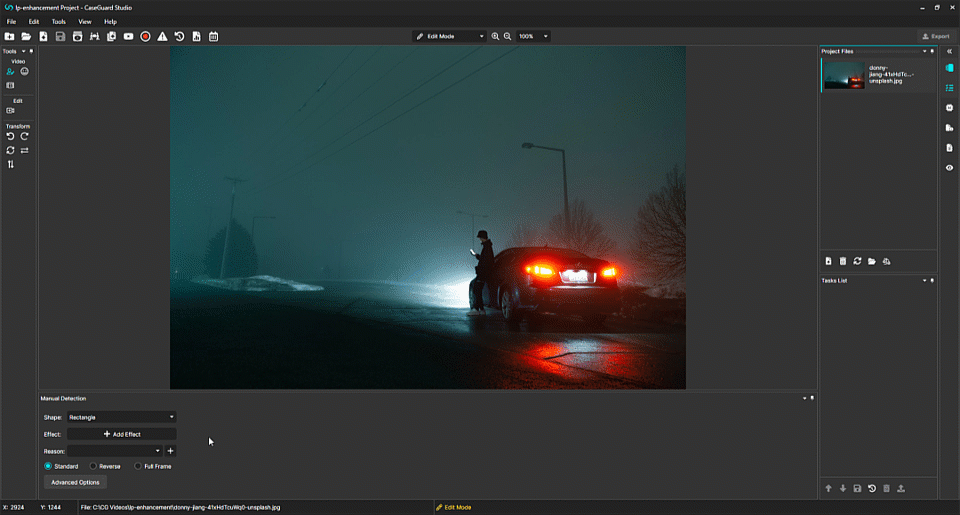How can AI Technology Prevent and Solve Crimes?
January 17, 2025 | 4 minutes read
“Smile, you’re on camera”. Warnings like these can be seen in homes, retail outlets, and offices as a means to deter illicit activities through the threat of video surveillance. In popular crime procedural shows such as NCIS, CSI, and The Rookie, the investigation of a crime often commences with the analysis of surveillance camera footage, hunting for clues about the incident and its perpetrators. Forensic Scientist Abby Sciuto from NCIS has rendered obscure license plates readable, unveiled obscured tattoos by inverting colors, and contributed to solving numerous crimes through video enhancement. So why can’t you and your department do the same?
In crime procedural dramas, much like in reality, crime scene footage can be introduced into court proceedings as evidence. To do this, innocent bystanders’ faces and license plates must be redacted to maintain their privacy. But, imagine a single software solution that could handle all these tasks.
Crime and Surveillance Footage
An article by The New York Times attributes the significant reduction in crime in East Orange, New Jersey, between 2003 and 2006 to the implementation of audio and video surveillance systems. The impact of these systems was tremendous, with crime rates witnessing a decrease of over 50%, a success the department credits to its robust surveillance infrastructure.
American District Telegraph (ADT), a well-known security company, claims that the presence of a video camera as part of a home security system can make a home 300% less likely to be targeted for break-ins. Their rationale is simple: criminals do not want to be caught on camera committing a crime.
As video surveillance proves more effective, we expect more cities, businesses, and homeowners to upgrade their security systems with cameras. This proliferation of camera use inevitably amplifies the probability of capturing criminal activities on film, thereby aiding law enforcement with tangible evidence for court proceedings.
Enhancing License Plates With CaseGuard
Imagine you’re a forensic scientist. A jewelry store has been robbed, and while the culprits wore masks, they neglected to hide the license plate on their escape vehicle. What’s your next step? If you’re equipped with CaseGuard Studio, an AI-powered all-in-one redaction software, the solution is straightforward. By employing powerful enhancement effects, a blurry license plate in a video or image can be made legible in just a few steps.

Simply upload your video to CaseGuard Studio and apply four enhancement effects to the license plate. Use ‘Magnify’ to zoom in, ‘Sharpen’ to refine pixel quality, ‘Grey Scale’ to distinguish between characters, and ‘Contrast’ to brighten or darken the image until the license plate becomes readable.
With a clear view of the license plate, you’re now equipped to accurately identify the criminals and apprehend them.
Video Redaction
It’s detective time. Imagine there’s been an assault, recorded on camera, but before the footage can be admitted as court evidence, you must redact the bystanders. Manual redaction could take hours if not days. However, powerful AI like that found in CaseGuard Studio, trained specifically to recognize faces, can achieve redaction in real time or less. The video below shows how to detect and redact multiple faces simultaneously with just a few clicks.
![Video Thumbnail]()
Play Video
But CaseGuard Studio’s AI doesn’t stop at facial recognition. It can identify screens, license plates, cars, documents, and more. Streamline your investigation process with an all-inclusive redaction solution like CaseGuard Studio, capable of swiftly and accurately enhancing and redacting video, audio, images, and documents.
Reports
Imagine you’re in court and the defense questions the validity of your video evidence. They suggest that during the redaction process, the video could have been manipulated to frame their client. With automatically generated reports from CaseGuard, you can easily prove no tampering took place.
CaseGuard creates an automatic redaction log, detailing the type of redaction applied, and the exact time in the video it was placed, and it even allows you to add a justification for each redaction, connected to its legal basis.
Beyond the redaction log, CaseGuard also produces a standard report. This document records all actions taken on the file and includes the file’s metadata, further validating it as untampered evidence in court proceedings.